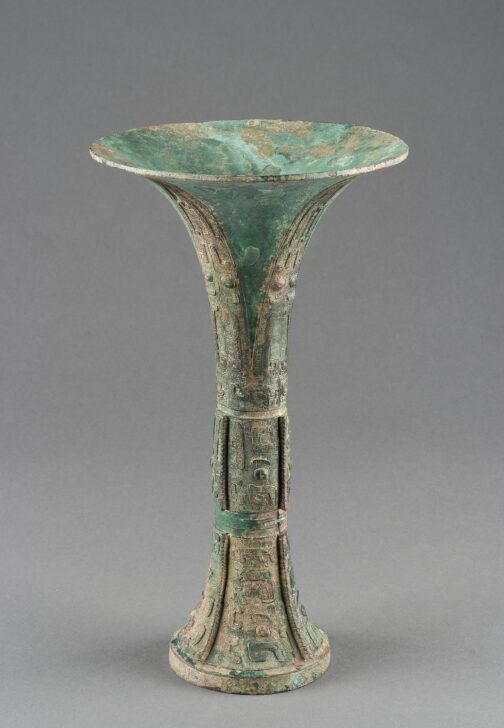Gu (libation goblet, one of a pair with 1948/1.117)
Chinese

Description
The "ku" is a wine container which was paired with the "chüeh" drinking cup. It is thought that the shape was derived from the combination of two elongated containers, one resting on top of a base made from a second one turned upside down.
Metalworking emerged around 2000 BCE in China, with bronze vessels appearing around 1600 to 1500 BCE in what is known as the Shang dynasty (DATES). Shang society followed the Neolithic societies of Northern China and is the first historically recorded civilization of China. Chinese writing was invented by the Shang and the short inscriptions they left on oracle bones and bronze vessels, along with extensive excavations, show a complex and highly organized society headed by a king and his family, administered by officials, and serviced by craftsmen, slaves, and prisoners of war. The dynasty occupied three capitals in Henan province, the last of which, Anyang, (ca. 1300-1050 BCE) was located south of present-day Beijing. It was in Anyang that some of the world’s greatest masterpieces of bronze art came into being.
Gu or wine containers were usually found in tombs paired with the Jue, drinking cup, indicating a close, indicating a close connection between them in Shang ritual practice. As demonstrated by this pair of tall and slender gu, late Shang bronzes have the main zoomorphic motifs of the taotie mask and kui dragons raised above the background spirals.
(Label for UMMA Chinese Gallery Opening Rotation, March 2009)
Subject Matter:
Elaborately decorated bronze wine goblet used in elite feasting or for offering wine at ancestral rituals in early China. Often used as part of a set of ritual vessels and placed in the burials of the Shang elite. The surface is decorated with tao-tie design, and the foot is inscribed with the clam emblem or the elite person to whom the vessel is dedicated.
Physical Description:
Wine drinking goblet or beaker with a wide, trumpet-shaped mouth, narrow, banded waist, and flaring foot. The slender silhouette of the vessel suggests a date towards the end of the Late Shang period. The body is decorated with Tao-tie mask design, divided by the elaborate raised flanges. An inscription is found inside the flaring foot, presumably the name of the person that the vessel is dedicated.
Usage Rights:
If you are interested in using an image for a publication, please visit https://umma.umich.edu/request-image/ for more information and to fill out the online Image Rights and Reproductions Request Form.